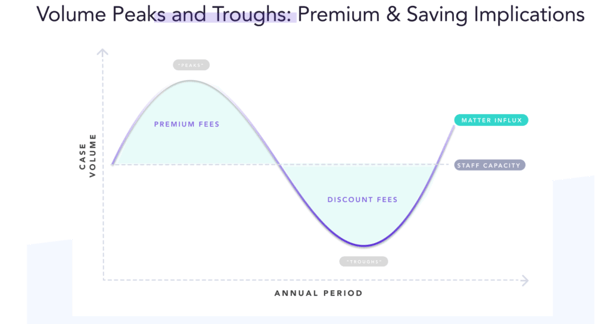
Law department clients have begun to send RFPs to firms for every matter in a Market-Driven AFAs process that has produced more cost-effective and quality-driven results than traditional panel-based RFPs alone. Why would a client need to run RFPs for every matter when they’ve already put a panel in place?
Market-Driven AFAs provide in-house teams an average savings of 37% on outside legal fees compared to hourly rates set from the traditional panel RFP process. That is in large part because firms themselves benefit from the process. Here are the top 3 reasons how they can pass the savings on to clients:
1) Available Staff Capacity
Firms’ capacity to work on a given case varies throughout the year. Sometimes a firm becomes understaffed due to an influx of work (i.e., “peaks”); sometimes a firm is overstaffed due to a dearth of work (i.e., “troughs”). And because firms’ staffs are fixed during a given year, firms cannot adjust staff numbers during troughs. It is imperative that firms earn additional work to avoid trough periods.

(Think of a law firm like an airline: much like an airline can’t adjust its seat count when people aren’t buying flights, a firm cannot adjust its labor capacity at any given time of the year, when that capacity is being unused.)
Idle lawyers are essentially latent assets that need to be working on matters to generate revenue for the firm. Matter-level RFPs are chances to fill troughs with case assignments. What is the best way to win case assignments during a trough? Discounts. Panel firms will offer lower fixed fee proposals during their troughs in order to ascend back to peak. Traditional, non-AFA RPFs do not offer those chances to avoid a trough.
Like an airline that provides steep discounts to those that book unpopular flight days, a firm will provide steep discounts to those that provide work during troughs. To keep borrowing from the airline analogy, matter-level cases under AFAs ‘fill seats’ when they’re vacant. In contrast, negotiating rates on an annual basis (rather than on a matter-based frequency) is like asking an airline for discounted seats even when seats are full. Ongoing rates may not ‘fill the seats’ when a firm may need it.
2) Clear Revenue Opportunity
The key term is “matter level:” firms recognize a clear revenue opportunity when there is a singular matter created. In contrast, a firm’s presence on a clients panel rarely guarantees a firm any level of volume of work. A client may have up to 40 firms on their panel, which hardly sets the foundation for consistent business. The firm still needs to win the work on a matter-by-matter basis. Market-Driven AFAs give panel firms the opportunity to participate in more proposals and as a consequence the opportunity to win more work.
3) Specialized Marketability
Law firms are always asked to reference key case victories that they’ve achieved for other clients within the firm selection process. If a partner can claim to have saved a company millions in a relevant, high-profile case, they have a leg up on the competition. Market-Driven AFAs give firms an opportunity to revise initial proposals, making their offer more attractive to clients. By doing this, they’re more likely to win marquee work from clients. Lawyers are competitive by nature; and simply put, firms want your work!